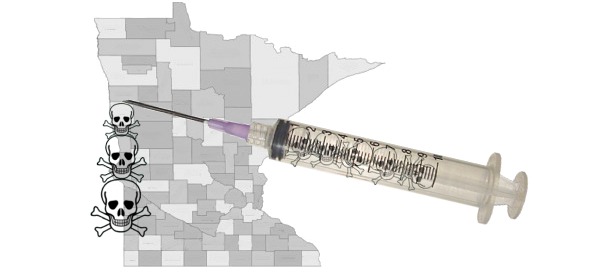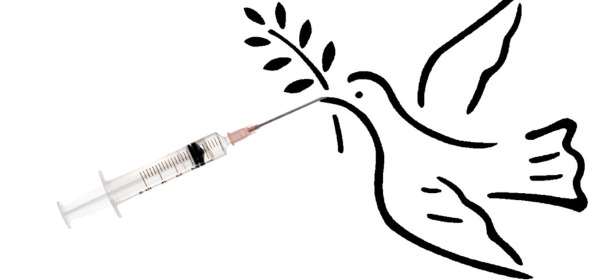Featured
HPV Vaccines: Scientists Use Manufacturers’ Data to Prove Lack of Efficacy
Real science trumps pseudo science! Serious scientists have taken on Merck’s Gardasil and GSK’s Cervarix to see how well the claims of their pseudo science hold up. The upshot is that they don’t—not in any sense. Here’s what they found.
by Heidi Stevenson

Image Cropped from MorgueFile Photo, slightly modified & syringe added.
Using the manufacturers’ own studies designed to gain government approval, three real scientists shred it to demonstrate that neither Gardasil nor Cervarix can come close to demonstrating effectiveness in preventing cervical cancer.
The researchers went straight to the studies provided by the manufacturers, Merck, manufacturer of Gardasil, and GlaxoSmithKline (GSK), manufacturer of Cervarix. They analyzed the results that were used to grant manufacturing approval and post-marketing studies that were also required. The results are utterly damning, not only of the manufacturers, but also the agencies, including the Food and Drug Administration (FDA) of the US and the European Medicines Agency (EMA) of the EU.
Of course, the authors are more circumscribed in how they describe it, but I don’t have to be. These reports are stunning in their implications of malfeasance on the part of the vaccine manufacturers and the health agencies that approved the vaccines.
Three researchers, Lucija Tomljenovic, Jean Pierre Spinosa, and Christopher A. Shaw, are publishing “Human Papillomavirus (HPV) Vaccines as an Option for Preventing Cervical Malignancies: (How) Effective and Safe?”1 (Only the abstract is available ahead of print.) Tomljenovic and Shaw published an abbreviated version, “Too Fast or Not Too Fast: The FDA’s Approval of Merck’s HPV Vaccine Gardasil”2, which is available now.
The authors point out that clinical trials produced by Merck indicated that Gardasil is 100% effective in preventing precancerous cervical lesions caused by the HPV-16 and HPV-18 viruses. Since, according to the World Health Organization (WHO), these viruses are responsible for 70% of all cervical cancers, it appeared that the vaccine could prevent 70% of all cervical cancers, so public health agencies quickly approved it. As they point out, executive orders have been issued mandating the vaccine for all 11 and 12 year old girls.
Sadly, and indicative of a virtually complete lack of genuine oversight by the agencies charged with public health, the truth was hidden in plain sight. Specific areas of concern examined by the authors are:
… (1) duration of protective immunity; (2) efficacy against oncogenic HPV strains not covered by the vaccine; (3) possibility of increased frequency of infection with these types; (4) efficacy in women acquiring multiple HPV types; (5) effects in women with pre-existing HPV infections; and (6) probability of serious adverse reactions (ADRs).
Each of these issues was tackled. This article does not attempt to cover everything that the authors did, as it’s much too involved and broad. However, specific and shocking information is reviewed. First up is Gardasil.
Surrogate Markers
Cervical cancer takes 20-30 years to develop from HPVs (human papillomaviruses). That’s a long time to do studies about the efficacy of a vaccine, so surrogate markers were used. Specifically, they focused on cervical intraepithelial neoplasias (CINs), the lesions that develop on the cervix that Pap (Papanicolaou) tests look for. These lesions are classed as levels 1, 2, and 3, with level 1 being the earliest stage.
The problem, of course, is that these lesions are not cancer, and the vast majority of them resolve without any intervention. A study is cited showing that, in teenage girls, “38% of CIN 2 resolve after one year, 63% after two and 68% after three years”. CIN 2 is also known to be infamously badly diagnosed. CIN 2 is the primary marker used by Merck for Gardasil approval.
CIN 3 lesions, though closer to cancer, are also problematic. Their diagnosis is complex, so subject to error, their progression is very slow, and some regress back to normal tissue. A finding of CIN 3 is not a diagnosis of future cancer. It takes 5 years for 20% of CIN 3 lesions to progress to cancer and only 40% have progressed to cancer after 30 years. CIN 3 is the other marker used for Gardasil.
Finally, it must be noted that finding a lesion does not mean finding an HPV-16 or HPV-18 induced lesion. So, taking all these points (and more) into consideration, the authors state:
Thus, the overall (global) efficacy of HPV vaccines, that is reduction of CIN 2/3 due to all high-risk types rather than just HPV-16/18, would be the most relevant measure
outcome both for the individual patient and in terms of overall public health benefits.
Referencing only these facts and analyzing Merck’s own data, including both pre-licensing and post-licensing studies, the authors are able to show that the efficacy of the Gardasil vaccine cannot be shown to have prevented a single case of cervical cancer, let alone preventing death from it.
The researchers reviewed several trials and took all into account. The initial, pre-licensure trials give a much better impression than the post-licensure trials. In looking at the HPV-16/18 only references, the results look good, but the number of cases of CIN 2 or 3 is very low compared to the numbers in the trials, making these results fairly insignificant. When you add in all the lesions that were not associated with HPV-16/18, then the figures change dramatically. Instead of showing 100% efficacy, the number falls as low as 14.4%. And this rate isn’t even based on actual cancers, but only on CIN 2 and 3, neither of which has a high likelihood of progressing to full-fledged cervical cancer.
Keep in mind that the rate of cervical cancer mortality has dropped by 70% since Pap smears have become routine. Because the HPV vaccines do not reduce the need to do Pap smears, since there are several other cervical cancer-related HPVs to screen for cancer, there is no benefit in Gardasil.
The post-licensure data available on Gardasil is, frankly, not worth considering. Merck did not provide information on results that take into account all HPVs. As you can see from the previous paragraphs, without that, the data is meaningless.
Quality of Gardasil’s Studies
Two issues are indicative of poor study designs. The first is that no p-values were given. P-values are estimates of the likelihood that a study’s results are by chance. The lower the value, the lower the likelihood of the results being obtained by chance even if there’s no difference between the groups. But Merck didn’t provide p-values.
The other problem is the confidence intervals (CIs). The CI is the range of values required to produce the confidence listed for the results given. A narrow range is much better than a wide range. In nearly all the studies on Gardasil, the CIs were not only wide, they were enormous. This is a strong indication that there’s something wrong with the study design.
Pre-Infected Cases
One of the most damning factors is the reported results in girls and women who were already infected with one of the viruses associated with Gardasil, HPV-6/11/16/18. In this case, the efficacy was negative. That is, the studies reported that women who were already infected were more likely to develop precancerous lesions than they were if they’d never had the vaccine! They were as much as 44.6% more likely to develop lesions or have them worsen because of the vaccine. Yet, Gardasil is given without any consideration of HPV status.
Efficacy Standards Not Met
The issue of surrogate markers is common in modern medicine’s pseudo science. In most cases, they’re used for the specific purpose of evading the truth, as in treating cholesterol levels as if they were clear indicators of impending heart disease, which they aren’t. In the case of HPV vaccines, their use can be justified because of the extremely long time lag between infection and development of cervical cancer. However, if they’re to be used, they must be used appropriately. In the case of Merck, it appears that, not only were they incautious in the use of surrogate markers, they seem to have used them to hide the truth.
Their claims of 100% efficacy in preventing cancer were simply false, as the team of Tomljenovic, Spinosa, and Shaw have demonstrated. Merck needed to show that their vaccine, Gardasil, can prevent close to 70% of cervical cancer. Instead, they weren’t able to come even close to that figure. Their claim is based on the wrong data.
They achieved even those poor results in seriously flawed studies. Confidence intervals so wide that any result could have been reached, and not including p-values tells us that something is likely wrong. Yet, in spite of that, their figures still don’t add up.
Worse than the obviously poor quality of their studies is that their own data has shown that the vaccine is literally dangerous for women who get it when they’re already infected with a human papillomavirus. To Merck’s credit, they have not hidden that information, though they have not made it clear where it matters most, on the front lines where girls are vaccinated.
Clearly, Merck did not come close to meeting the needed standards of efficacy to justify the approval of Gardasil. But it gets worse, as you’ll see in the article about the HPV vaccines’ safety record. First, though, is the upcoming article on GSK’s Cervarix efficacy.
Sources:
- Human Papillomavirus (HPV) Vaccines as an Option for Preventing Cervical Malignancies: (How) Effective and Safe?
- Too Fast or Not Too Fast: The FDA’s Approval of Merck’s HPV Vaccine Gardasil.
Tagged big pharma, cervarix, cervarix pseudo science, christopher shaw, gardasil, gardasil efficacy, gardasil pseudo science, gsk pseudo science, john pierre spinosa, junk science, merck pseudo science, pseudo-science, pseudoscience, public health agencies hpv, public health cervarix, public health gardasil, science, tomljenovic, vaccine, vaccine pseudo science, vaccine science, vaccines















Pingback: Cervarix, Like Gardasil, Doesn’t Do What Was Claimed: Research | Gaia Health
Pingback: Nuevos estudios sobre la eficacia de Gardasil y Cervarix en la prevención del cáncer « letritasnegras
Pingback: Impfungen machen erst krank! › Matrixblog Traumtagebuch über Träume, Astralreisen, Weltpolitik, luzides Träumen, UFOs, Aliens und Verschwörungen
Pingback: Scientists Point Out Corruption in Vaccine’s Promotion | The Liberty Beacon